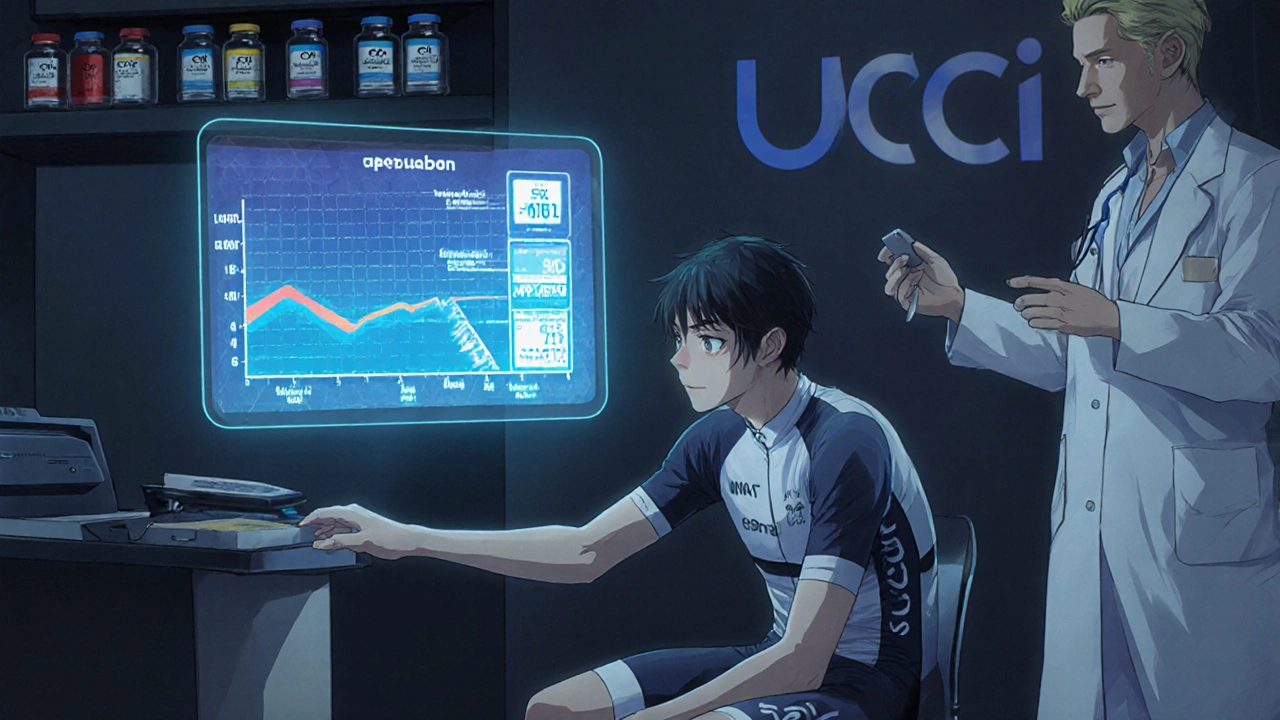Anticoagulant Sports Risk Assessment Tool
Assess Your Sports Risk Level
Select your sport to see its risk level and safety recommendations while on anticoagulants.
Risk Assessment Results
Medication Recommendations
Action Plan
Playing sports while on blood thinners isn’t just risky-it’s a tightrope walk between staying active and avoiding life-threatening bleeding. If you’re an athlete taking warfarin, apixaban, or another anticoagulant, you’re not just managing a medical condition-you’re managing your entire lifestyle. The good news? You don’t have to quit. But you must change how you approach training, competition, and recovery.
Why Sports and Blood Thinners Don’t Mix Easily
Anticoagulants stop dangerous clots from forming, but they also make it harder for your body to stop bleeding. In everyday life, that’s a trade-off most people accept. But in sports? A single fall, collision, or even a hard tackle can turn into a serious internal bleed. Studies show athletes on anticoagulants have a 3 to 5 times higher risk of major bleeding than non-athletes. That’s not a small number-it’s a red flag.It’s not just about contact sports. Even in soccer or basketball, where collisions aren’t constant, a misstep can cause a deep muscle bruise that turns into a hematoma. In extreme cases, that can lead to compartment syndrome or internal bleeding that needs emergency surgery. And if you’re on warfarin, your INR (a blood test that measures clotting time) can swing unpredictably, making it even harder to know when you’re safe.
The Three Levels of Sport Risk
Not all sports are created equal when you’re on blood thinners. Experts classify them into three clear risk tiers:- High-risk sports (avoid completely): Football, rugby, ice hockey, boxing, wrestling. These involve forces over 5G and a 90% chance of trauma. Even a minor bump can cause bleeding in the brain, liver, or spleen. No exceptions.
- Intermediate-risk sports (proceed with caution): Basketball, soccer, skiing, mountain biking, martial arts. These have a 30-60% chance of impact. You might still play-but only after a detailed plan with your doctor.
- Low-risk sports (generally safe): Running, cycling, swimming, rowing, yoga, golf. Trauma risk is under 10%. These are your best options if you want to stay active without major risk.
A 2018 study found that athletes in high-risk sports had a 22.7% chance of major bleeding. In low-risk sports? Just 1.3%. That’s not a coincidence-it’s a clear guide.
Warfarin vs. DOACs: Which One Lets You Play?
The type of blood thinner you take changes everything.Warfarin has been around for decades. It’s cheap, but it’s a nightmare for athletes. It needs weekly blood tests (INR), reacts with vitamin K-rich foods like spinach and broccoli, and interacts with dozens of medications. Its half-life is 36-72 hours, meaning once it’s in your system, you can’t quickly turn it off before a game. If your INR is too high during competition? You’re playing with fire.
Direct oral anticoagulants (DOACs)-like apixaban, rivaroxaban, and dabigatran-are newer, smarter, and far more athlete-friendly. Their half-lives are short: apixaban clears in 8-15 hours, rivaroxaban in 5-13. That means you can time your dose so the drug’s effect drops right before competition. For example, a cyclist might take apixaban at 8 PM the night before a race, so by race day at 10 AM, the drug’s concentration is low enough to reduce bleeding risk-but still high enough to prevent clots.
A 2025 JAMA study of over 160,000 patients found apixaban had the lowest risk of major bleeding compared to rivaroxaban and warfarin. It also had the lowest rate of recurring clots. For athletes, that’s the sweet spot: protection without excess risk.

Four Proven Strategies to Stay Active
If you’re determined to keep competing, here are four strategies backed by real-world data:- Switch to low-impact sports: Run instead of play basketball. Swim instead of ski. A 2023 study showed that athletes who moved from intermediate to low-risk sports cut their major bleeding risk from 8.2% to 1.9%-without giving up exercise.
- Temporarily lower your warfarin dose: Some doctors reduce warfarin 3-4 days before a competition to bring INR down to 1.5-1.8. This lowers bleeding risk but increases clot risk to 0.8% per event. Only do this if your clot risk is low and you’re monitored closely.
- Use LMWH with timed breaks: Low molecular weight heparin (like enoxaparin) is injected daily. You can skip the dose 24 hours before your event. This keeps clot protection strong while reducing bleeding risk by 42%. It’s common in elite athletes who need short-term control.
- Time your DOAC dose: This is the most advanced-and most effective-approach. A professional cyclist in a 2023 case study took apixaban at 8 PM, raced at 10 AM the next day, and had a subtherapeutic level during competition. His clot protection stayed above 95%, and bleeding risk dropped by 37%. This requires a special blood test (anti-Xa assay) to confirm levels, but it’s becoming standard in top-tier sports medicine.
What the Experts Say
Dr. Paul D. Thompson, who helped write the AHA/ACC guidelines, says: “Athletes aren’t just patients-they’re people with goals. The goal isn’t to take away their sport. It’s to help them play safely.”Dr. Matteo Palamà, a leading researcher in Europe, argues DOACs should be first-line for athletes because they allow precise timing. “You can’t manage warfarin like a race schedule,” he says. “But you can with DOACs.”
But there’s a problem: almost no clinical trials include athletes. Only 0.3% of participants in major anticoagulant studies were competitive athletes. That means most guidelines are based on data from older, sedentary patients. You’re part of an emerging group that’s rewriting the rules.

What You Can Do Right Now
If you’re on anticoagulants and want to stay active:- Get a full risk assessment: Use tools like CHA2DS2-VASc (for atrial fibrillation) or HERDOO2 (for prior clots) to understand your personal clot risk.
- Ask your doctor about switching to apixaban if you’re on warfarin. It’s safer, easier to manage, and more compatible with sports.
- Never play high-risk sports. No exceptions. Even if you feel “fine.”
- Wear protective gear-even in low-risk sports. Helmets, pads, and impact-resistant clothing can make the difference between a bruise and a bleed.
- Keep a record: Track your medication times, doses, and any injuries. Bring this to every appointment.
- Check with your sport’s governing body. The NBA requires INR under 2.0 for players on warfarin. The UCI allows DOACs if you skip the dose 24 hours before racing.
The Future Is Personalized
New tech is making this easier. The CoaguChek INRange device lets you check your INR at home with 95% accuracy. Wearable sensors are now measuring impact forces in real time during sports-data that could one day tell your doctor exactly how much risk you’re taking in each activity.By 2028, experts predict a 40% rise in athlete anticoagulation consultations. That’s not because more people are on blood thinners-it’s because more people are demanding to stay active while on them. The medical world is catching up.
You don’t have to give up your sport. But you do have to be smarter about it. The goal isn’t to avoid all risk-it’s to manage it so you can keep doing what you love, without putting your life on the line.
Can I still play basketball if I’m on blood thinners?
Basketball is classified as an intermediate-risk sport with a 30-60% chance of trauma. Most experts advise against playing while on anticoagulants due to the high risk of internal bleeding from collisions or falls. If you’re determined to play, you must work with a specialist to explore strategies like switching to a DOAC (e.g., apixaban) and timing your dose to minimize anticoagulant levels during games. Even then, protective gear and strict injury monitoring are essential. Many athletes choose to switch to lower-risk alternatives like cycling or swimming instead.
Is apixaban safer than warfarin for athletes?
Yes. A 2025 JAMA study of over 160,000 patients found apixaban had a 26% lower risk of major bleeding and a 33% lower risk of recurrent clots compared to warfarin. Apixaban also has a shorter half-life (8-15 hours), meaning you can time your dose to reduce its effect before competition. Warfarin requires frequent blood tests, reacts with food, and can’t be easily adjusted for sports. For athletes, apixaban is the preferred choice unless you have a mechanical heart valve, where warfarin is still required.
Can I stop taking my blood thinner before a race?
Stopping anticoagulants without medical supervision is dangerous and can cause life-threatening clots. However, under doctor supervision, timed interruptions are possible. For DOACs like apixaban, skipping the dose 24 hours before an event is a proven strategy that reduces bleeding risk by 37% while keeping clot protection above 95%. For warfarin, lowering the dose 3-4 days before is an option, but it increases clot risk to 0.8% per event. Never stop or adjust your medication without a plan from your cardiologist or anticoagulation specialist.
Do I need to tell my coach or team I’m on blood thinners?
Yes. Your coach, trainer, and teammates should know you’re on anticoagulants. In case of injury, they need to recognize signs of internal bleeding (unexplained swelling, dizziness, severe pain) and avoid giving you NSAIDs like ibuprofen, which increase bleeding risk. Many sports organizations now require disclosure for safety protocols. This isn’t about privacy-it’s about emergency preparedness.
Are blood thinners banned in sports?
No. The World Anti-Doping Agency (WADA) clarified in 2020 that therapeutic anticoagulants are not performance-enhancing drugs and are permitted with proper documentation. You must declare your medication through a Therapeutic Use Exemption (TUE) if required by your sport’s governing body (like the UCI or NBA). As long as you’re taking the medication for a legitimate medical reason and following your doctor’s plan, you’re compliant with anti-doping rules.
What to Do Next
If you’re on anticoagulants and active:- Book a consultation with a sports cardiologist or anticoagulation specialist.
- Ask about switching to apixaban if you’re on warfarin.
- Map out your sport’s risk level using the high/intermediate/low categories.
- Start wearing protective gear-even in low-risk sports.
- Keep a medication log and share it with your team.
You don’t have to choose between health and passion. With the right plan, you can do both. But only if you act now-before an injury changes everything.


